With the lightning speed of technological evolution, the demand for high performance yet sustainable natural fibres reinforced polymer composites (NFPCs) are rising. Especially a mechanically competent NFPCs under various loading conditions are growing day by day. NFPCs mechanical properties highly depend on strain rate due to their viscoelastic and viscoplastic behaviour. Pure viscoelastic behaviour usually occurs within a small amount of strain. While the viscoplastic inelastic strain only accumulates when it reaches a certain amount depending on the material. NFPCs under a different type of strain rates could also exhibit diverse mechanical properties and failure mechanism.
- natural filler
- polymer composite
- various strain rates
1. Background
High-performance requirements and environmental regulations nowadays have risen the demand of industries to utilize green composites materials. It has also become the main driving force of recent research on the development of eco-friendly yet sustainable natural fibre reinforced polymer composites (NFPCs) instead of synthetic one. It is well-known that synthetic fibres reinforced polymer already has out-standing properties and applications. For instance, glass fibre reinforced polymer known for its excellent properties was able to be utilised for sleepers of railway track [1]. Phenolic-based glass fibre polymer composites have good fire-retardant properties to meet the fire requirement of building materials [2]. However, in order to satisfy the eco-friendly aspect, reinforcement using natural fibres may be a better choice as they can be obtained from plants, animals and agriculture wastes. Over the past decade, agriculture waste fibres have been the favourite choices of researchers for its sustainable resources. Example of agriculture waste fibres is oil palm, bagasse, corn, stalks, coir, bamboo, pineapple, banana and rice husk. These fibres are normally extracted from part of the plant such as stem, leaf, seed or even its fruit [3].
NFPCs are strain rates sensitive due to the viscoelastic nature of their matrix. In simpler terms, NFPCs’ mechanical properties are highly dependent on the strain rates [4]. Strain rates mean the rate of change of strain or a measure of deformation per unit second (s−1). Strain rates have a wide application in common civil structures with levels ranging from low to very high rates. For instance, low strain rates (<0.1 s−1) have application in materials’ creep, quasi-static deformation of structures, vehicle impacts, some parts of plane crash and earthquake or wind-induced dynamic motion of high-rise building [5][6][7]. While for high strain rates (>0.1 s–1), there are applications such as armour penetration, crashworthiness of materials, blast, hard impacts from plane crash, missile and rockfalls [7][8]. Apart from civil structures, manufacturing processes also involved with strain rates. For instance, material forming, high-speed machining, potential application of superplastic forming and diffusion bonding and automatic control manufacturing system [8][9].
Like any other viscoelastic materials, NFPCs properties such as the stress–strain behaviour, failure mechanism and failure probability are distinctive under different ranges of strain rates. According to the first law of thermodynamics, force or energy applied on viscoelastic material cannot be destroyed but conserved into two different forms, i.e., elastic and viscous parts. Part of applied energy will be stored into materials as internal energy and the other part will be dissipated as heat. While the viscoelastic material will have viscosity change with strain rate, it will cause a different amount of viscous drag and frictional energy loss within the materials [10]. Consequently, it causes the mechanical properties NFPCs to be rather complex under various strain rates and required further studies.
2. Strain Rates Characterisation
Conventional research toward NFPCs mechanical properties was conducted under constant quasistatic condition. However, researchers over the past decade have started to focus on strain rates effect toward NFPCs. Table 1 shows a wide strain rates regime that has been studied and their respective experimental techniques. It can be any form of strain rates including tension, compression, bending and impact depend on the equipment listed.
Table 1. Summary of strain rate corresponding experimental technique.
| Strain Rate Regime | Experimental Technique |
|---|---|
| Low rate ε˙<0.1s−1 |
Conventional mechanical universal tester Electronic universal testing machine |
| Medium rate 0.1s−1≤ε˙≤200s−1 |
Mechanical tester with ultra-capacity Split Hopkinson pressure bar (SHPB) Drop weight Servo-hydraulic testing machine |
| High rate 200s−1≤ε˙≤105s−1 |
Split Hopkinson pressure bar (SHPB) Taylor rod impact |
| Very high rate ε˙>105s−1 |
Flyer plate impact |
Conventional mechanical tester for example for screw-type universal testing machines are routinely used to characterise the stress–strain behaviour of materials under strain rate of 0.1 s−1 and below. A specifically designed high-capacity servo-hydraulic driven, high-speed control and data-acquisition instrument can achieve higher strain rates under compression testing due to ease of positioning. However, such specialised equipment is extremely expensive and required caution on ensuring the accuracy of measured parameters are not affected by the dynamics of the structure itself under higher strain rate test [11].
As for higher strain rate setup, i.e., 200 s−1 and above, Hopkinson pressure bar is a common choice among the researchers. However, there are still reported gaps for fibre material testing at high strain rates which is difficult to close using existing measurement setups including high-capacity servo-hydraulic driven testing machines and Hopkinson pressure bar. A novel test method by using a rotary drive machine also face challenges in coupling force, reliable clamping specimen and high-speed data acquisition issues above the strain rate of 267 s−1 [12]. While for the flyer plate impact technique, commonly a gas gun plate impact is used in shock dynamic laboratory. Although it is capable of precisely controlled impacts with velocity up to 1.5 mm/µs, it is mainly used for impact test and much higher cost equipment [13].
3. NFPCs under Different Forms of Strain Rates
3.1. Tensile Strain Rate
Tensile strain rate is one of the strain rates types that have been studied by numerous researchers in recent decades toward NFPCs. For instance, a recent study on pure HDPE (High-Density Polyethylene) and hemp-HDPE composites found that the young modulus and tensile strength increase as the strain rate increase due to strain hardening effect [14]. This result indicated that short hemp fibre reinforced composite mechanical behaviours was dominated by the matrix. The normalised tensile stress–strain behaviours of polymer under extreme cases based on studies are represented in Figure 1. Increase the strain rate experience by the polymer could lead to increasing strength but brittle behaviour due to shorter stress relaxation time [15]. However, the amount of stress and strain increase or decrease are very dependent on the reinforcement. Another study found that the flax fibre reinforced epoxy shows a significant increment of tensile strength under high strain rate loading although it did not show much variation at low strain rate [16]. In addition, different types of natural fibres reinforcement, i.e., banana, bamboo and flax fibre reinforced composites were found having different amounts of tensile strength increment as the strain rate increases. Flax/polyester composites were found to exhibit the highest tensile strength compared to banana/polyester composites and bamboo/polyester composites. It could be due to the highest tensile strength of flax fibre than the banana and bamboo fibre [17]. Which indicates the composite strain rate sensitivity is reliant on the type and form of natural fibre reinforcement.
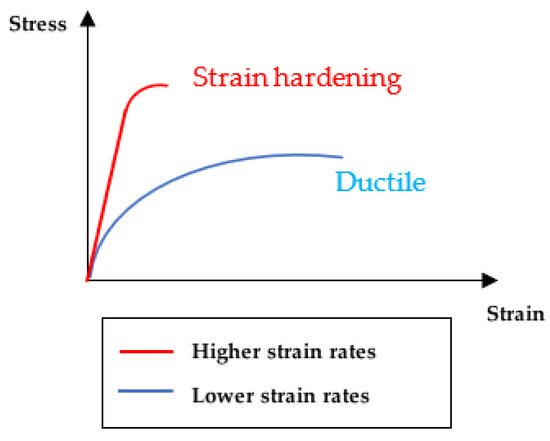
Figure 1. Normalised tensile stress–strain responses as the strain rate increased.
Furthermore, recent studies have found micron/whisker form of fibres can cause the composite to become more crack sensitive and exhibit unpredictable brittle fracture behaviour under varying tensile strain rate. For instance, some micron-sized agriculture waste fibre like wood and coir are sensitive even under low and small strain rate variations. The crack initiation rate and propagation are highly affected by strain rate variation. The uneven particle sizes can result in micro-cracks and act as localized stress generators, initiating structural heterogeneities and the resulting failure of material [18][19]. The tensile strengths of coir filler composites, in general, were decreasing as the crosshead speed increases (strain rate increases) and crack blunting, crack pining, crack front-twisting contributed as fracture mechanism with micro-sized particle reinforcement [20].
Figure 2 shows the crack propagation behaviour due to the presence of unevenly sized filler which could cause the tensile properties unpredictable under various strain rates. Another study on bamboo–polyester composites has also found that the tensile strengths were fluctuating under various low strain rates [19], where the composite strength gradually increased with increase in strain rate from 0.1 mm/min to 0.5 mm/min and then gradually decreased from 0.5 mm/min to 1 mm/min. After that the strength increased significantly up to 20 mm/min [21].
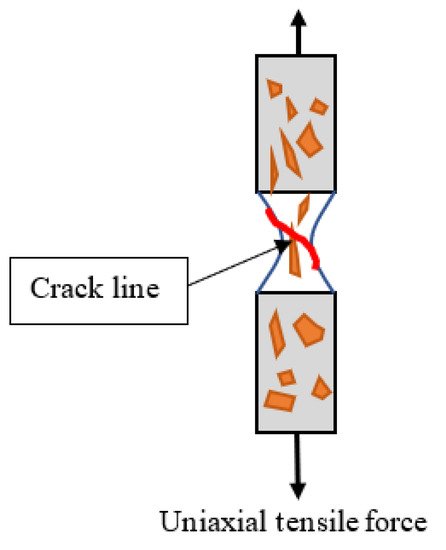
Figure 2. Crack propagation of micron coir filler composite.
There is also research conducted under high strain rates. For instance, flax fibre reinforced composite with similar behaviour as carbon fibre composite shows a significant change of properties under higher strain rates. The strain rate sensitivity of fibre could also be one of the factors affecting the sensitivity of overall NFPCs. The energy absorption (area under stress–strain curves) of the flax fibre composites significantly increases after 79.12 s−1 of strain rate [16]. Furthermore, only a single critical fracture perpendicular to the loading direction occurred when the strain rates were less than 79.12 s−1 and multiple cross-sectional fractures were formed after 79.12 s−1, which consumed a huge amount of energy (Figure 3).
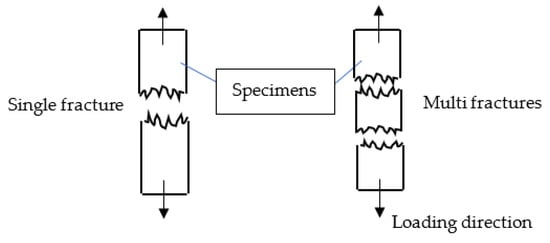
Figure 3. Single and multi-cross-sectional fractures.
Furthermore, a study found that smaller natural filler sizes (e.g., smaller bagasse particles reinforcement) may further enhance the composite’s tensile performance under various low strain rates. The composite’s overall strength and toughness are enhanced as the filler size go down. It could delay the filler-matrix debonding process through better filler dispersion and interface stress transfer [22]. Thus, the limitations of micron-sized natural fillers composites under varying strain rates could be addressed by reducing the sizes of fillers to nano-sizes or including other synthetic nanofillers as hybrid composites.
The study also conducted on fibre-matrix interface adhesion of plantain fibres polymer composite and its strain rate sensitivity through the interfacial energetics aspect. For instance, a study found that treating plantain fibres with different chemicals can affect the filler-matrix interface bonding [23]. Consequently, it may further influence the strain rate sensitivity index of the composite depending on the pull-out forces required.
3.2. Compressive Strain Rate
Recently a few researchers have investigated the behaviour of NFPCs under a different form of strain rates apart from tensile. As for compressive strain rate characterisation, it is similar to other forms of strain rates. The quasi-static and low strain rates are tested under universal mechanical tester while for high strain rates, split-Hopkinson pressure bar is commonly used [24][25][26].
According to study, the compressive properties of the composite depend on the types of filler reinforcement and matrix used [26]. From the study, hemp-vinyl ester composite was found less strain-rate dependent compared to glass-vinyl ester composite at strain rates higher than 1400 s−1 due to the hemp fibre only dissipate more energy at lower strain rates and the hybrid reinforcement using hemp and glass could result in behaviour intermediate between glass and hemp cases [26]. In addition, the addition of wheat straw fibres to different types of polypropylene (i.e., homopolymer and copolymer) has a different response at high strain rates. The polypropylene copolymer composite was found to exhibit better energy absorption properties at high strain rates compared to homopolymer composite [26].
Another studied on compressive strain rate sensitivity of hemp fibre reinforced epoxy composites found the stress–strain behaviour of hemp fibre-epoxy composite was quite different between quasi-static and high compression strain rate [24]. It can be described using normalised ductile and brittle stress–strain response curves (Figure 4). Under quasi-static compression, the composite shows different deformation stages similar to ductile deformation. The hemp fibre-epoxy composite shows initial elastic deformation and the crack initiated (Figure 4a (i)). Followed by Figure 4a (ii), a yield point where the crack continues grew with the fibres began to be pulled out from the matrix. In Figure 4a (iii), the composite finally experienced significant stress increase (plastic stage) and reached the fracture point. While under 2375 s−1 compression rate, the composite has an ultimate stress point and then experienced brittle failure represented by the steep decreasing stress after ultimate stress [24].
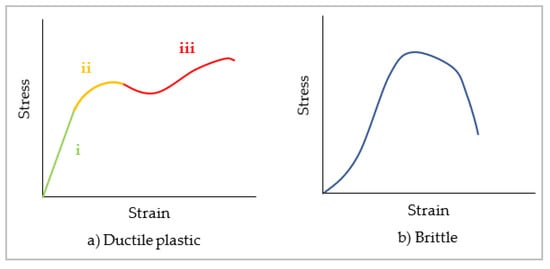
Figure 4. Normalised compressive stress–strain responses (a) Ductile, (b) Brittle.
Additionally, woven based NFPCs such as woven flax-epoxy composites, their final deformations are found to be different under various compressive strain rates. Based on the study from Hu et al. [27], the woven-flax epoxy composites have broken into small pieces under the highest compressive strain rates (2800 s−1) due to flax weave rupture. The energy absorption of woven flax-epoxy was found increased as strain rate increases at the same level of strain. It was deduced that apart from viscoelastic nature of flax fibre and epoxy itself, this phenomenon may also occur due to the crack formation and crack growth, which consumed more energy at higher strain rates.
As the viscoelastic polymer composite’s behaviour keeps changing under different strain rates, it is important to develop a constitutive model for the properties prediction. Hu et al. [25] have studied the use of simplified Johnson–Cook model to describe the compressive strain rate dependent on flax fibre reinforced composites. The simplified Johnson-Cook is commonly used to describe the coupling factors among stress, strain and strain rate. The dynamic behaviour of flax fibre composites was expressed using simplified Johnson-Cook as

where σ represent the stress; A is the yield stress; B and n are the effect of strain hardening; C is material constant depending on specific material representing its strain rate dependency; ε is the equivalent plastic strain; ε˙ represent strain rates and ε˙∗ is the dimensionless plastic strain rate expressed as ε˙ε0˙ with ε0˙=0.006s−1 based on quasi-static experiments. The Equation (1) was found good fit with the flax fibre composites stress–strain experimental data under various strain rates [25].
3.3. Flexural Strain Rate
In the case of the flexural strain rate, numerous studies have been available. Composites such as cork-powder epoxy were flexural strain rates sensitive. However, hybrid reinforcement of cork-powder epoxy composite using Kevlar and Carbon exhibited different bending strain rate sensitivity. A linear relationship observed between the logarithm of strain rate and bending properties which can be used to predict the strain rate effect. The bending strain rate sensitivity seems to be affected by the filler properties. Hence, the normalised stress–strain behaviours are similar to the cases under tensile loadings, but it could have non-linear response before fracture at higher strain rates (Figure 5). For instance, according to Silva et al. [29], Kevlar composites with pure resin, the maximum bending stress increases from 188.1 MPa at 1.3 × 10−1 s−1 to 243.3 MPa at 1.3 × 10−1 s−1, represents an increment around 29.3%. The stress–strain curve exhibit two region-a quasi-linear region and followed by a nonlinear region. Further filled the resin with cork powder, the flexural strength values are 182.9 MPa and 227.2 MPa, represents an increment around 24.2%. However, the bending stiffness also increased as the strain rate increase indicating the strain hardening effect.
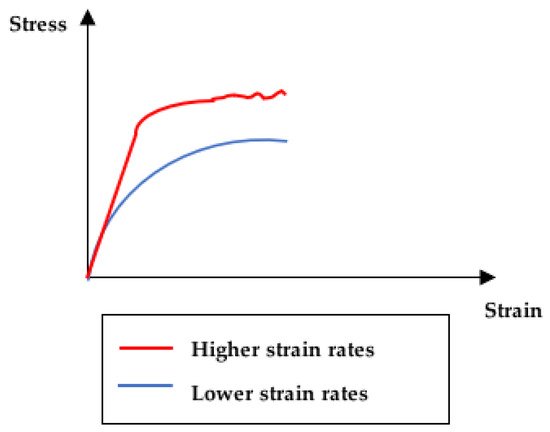
Figure 5. Normalised flexural stress–strain responses.
Furthermore, another study found that natural fibre loading content also plays an important role in the flexural performances of composites under dynamic strain rates. A research found that 3% coconut fibre reinforced composite can absorb about 83.23 J of energy under flexural high impact strain rates. However, the dynamic increase factors (DIFs) were solely influenced by strain rate (not by the fibre content of composites), where all 1%, 3% and 5% coconut fibre composites have a similar relationship between dynamic factors and strain rates, DIF=0.043[logε˙]2+0.436logε˙+1.0468 [30].
Another study investigated the effect of time (low strain rate—0.0026 to 0.26 s−1) towards flexural properties of wood-polypropylene composites to predict their long-term performance. It was found that the flexural strength of composites would increase linearly with strain rate. Storage modulus as a function of frequency also found to support the trend. The long-term performances of such composite were deduced to depend on their matrix and amount of wood filler incorporated. The research also showed that the relaxation time is reduced with the increase of strain rate resulting the strain of break of composite decreased [31].
Additionally, a study on jute reinforced polyester composite found that alkali-treated jute fibre could increase the loading rate sensitivity of composite under three-point bending [32]. The results show that fibre pull-out was the primary failure mechanism in alkali-treated conditions and interlaminar shear strength was increased due to the increase of composite stiffness at higher strain rates (strain hardening). The matrix has become brittle at higher strain rate as less crack-blunting was found under the microstructure using a scanning electron microscope [32].
However, most of the research towards bending is limited within low strain rates. It could be due to the lack of a standard testing method for strain rate-dependent tests. A commonly used technique for bending strain rate-dependent test is dynamic or impact 3-point bending. Such a setup is typically applied using conventional mechanical tester which cannot handle a high strain rate. Specimen thickness and support span length are subjected to optimisation for reducing contact lost between specimen and impactor, which is challenging at higher strain rates due to induced vibration [33].
3.4. Literature Summary
The studies of NFPCs under different forms and strain rates in this review are summarised in the Table 2 below. Based on this review, the NFPCs generally exhibit brittle failure as the strain rate increases no matter the forms of deformations (tensile, compression or bending) due to the strain hardening effect. However, with suitable reinforcement the properties seem to be further improved as the embrittlement delayed to a higher strain rate. Hence, more research is required to further understand and control the reinforcement from multiple aspects for example types of fillers, filler surfaces treatments, matrix etc.
Table 2. Summary of key findings from literature regarding NFPCs.
| Strain Rate Forms | Authors and Date | Composite | Key Findings |
|---|---|---|---|
| Tensile | Fotouh et al. (2014) | Hemp-HDPE | Young modulus and tensile strength of composite increase as the strain rate increase due to strain hardening effect. |
| Patel and Chokshi (2017) | Bamboo-polyester | Fluctuating composites tensile strengths under varied low strain rates. | |
| Giuliania et al. (2018) | Flax-epoxy | Composite exhibits both viscoelastic and viscoelastic behaviours which cause its properties to be highly dependent on strain rate. | |
| Chokshi and Gohill (2018) | Bamboo, Banana, Flax-polyester | Composite strain rate sensitivity is reliant on the type and form of natural fibres reinforcement. | |
| Wang et al. (2018) | Flax-epoxy | Composite shows significant increment of strength under high strain rate loading compare to low strain rate. Fibre sensitivity affects overall sensitivity of NFPCs. |
|
| Kumar et al. (2018) | Coir-epoxy | The rate of crack initiation and propagation are extremely affected by strain rate variation. | |
| Kumar et al. (2018) | Wood-epoxy | The tensile strengths of wood filler composites, in general, were decreasing as the strain rate increases. Crack blunting, crack pining, crack front-twisting as fracture mechanism with micro-sized particle reinforcement. |
|
| Kumar and Bhowmik (2019) | Coir-epoxy | The rate of crack initiation and propagation are extremely affected by strain rate variation. Uneven particle sizes result in micro-cracks and act as localised stress generators, initiating structural heterogeneities and resulting in early failure. |
|
| Debnath et al. (2020) | Bagasse-epoxy | The composites with smaller filler size exhibit higher tensile strength and toughness under various low strain rates. | |
| Sinebe et al. (2020) | Plantain-polyester | Different chemical treated fibre can influence the strain rate sensitivity of polymer composites through the interface adhesion strength. | |
| Compressive | Kim et al. (2012) | Hemp-vinyl ester, glass-vinyl ester, hemp/glass-vinyl ester, wheat straw-polypropylene (homopolymer & copolymer) | Hemp-vinyl ester was found less strain-rate dependent compared to glass-vinyl ester at strain rates higher than 1400 s−1. Hybrid reinforcement using hemp and glass resulted in composite behaviour intermediate between glass and hemp cases. Polypropylene copolymer composite was found to exhibit better energy absorption properties at high strain rates compared to homopolymer. |
| Hu et al. (2018) | Flax-epoxy | Significant increment in ultimate Compressive strength (61.2%) under varied strain rates. Composites broken into small pieces under highest compressive strain rates (2800 s−1) due to flax weave rupture. |
|
| Abu Seman et al. (2019) | Kenaf-polyester | Validated that the composite failed at more shattered fragment at higher compressive strain rates causing a non-linear behaviour using finite element analysis (meso-scale model). | |
| Hu et al. (2019) | Flax-epoxy | Use of simplified Johnson-Cook model to describe compressive strain-rate dependent of flax fibre reinforced composites. | |
| Xiang et al. (2020) | Hemp-epoxy | The stress–strain behaviour of the composite was found different between quasi-static and high compression strain rate. | |
| Flexural | Wang and Chouw (2017) | Woven flax fabric-epoxy wrapped coir-concrete | 3% coconut fibre reinforced composite can absorb about 83.23 J of energy under flexural high impact strain rates. |
| Silva et al. (2019) | Kevlar/cork powder-epoxy & Carbon/cork powder-epoxy hybrid composites | Hybrid reinforcement of cork-powder epoxy composite using Kevlar and Carbon can cause the different bending strain rate sensitivity depending on the filler properties. | |
| Wang et al. (2019) | Wood-polypropylene | Flexural strength of composite increased linearly as the strain rate increase. The strain at break of composite decreased as the strain rate increased due to shortened stress relaxation time. |
|
| Kumar et al. (2020) | Jute-polyester | Alkali-treated jute fibre could increase the loading rate sensitivity of composite under three-point bending. |
This entry is adapted from the peer-reviewed paper 10.3390/jcs5050130
References
- Ferdous, W.; Manalo, A.; AlAjarmeh, O.; Mohammed, A.A.; Salih, C.; Yu, P.; Khotbehsara, M.M.; Schubel, P. Static behaviour of glass fibre reinforced novel composite sleepers for mainline railway track. Eng. Struct. 2021, 229, 111627.
- Ferdous, W.; Ngo, T.D.; Nguyen, K.T.Q.; Ghazlan, A.; Mendis, P.; Manalo, A. Effect of fire-retardant ceram powder on the properties of phenolic-based GFRP composites. Compos. Part B Eng. 2018, 155, 414–424.
- Dungani, R.; Karina, M.; Subyakto; Sulaeman, A.; Hermawan, D.; Hadiyane, A. Review Article Agricultural Waste Fibers Towards Sustainability and Advanced Utilization: A Review. Asian J. Plant Sci. 2016, 15, 42–55.
- Gutierrez-Lemin, D. Fundamental Aspects of Viscoelastic Response. In Engineering Viscoelastic; Springer: Boston, MA, USA, 2014; pp. 1–25.
- Banavalkar, P.V. Structural systems to improve wind induced dynamic performance of high rise buildings. J. Wind Eng. Ind. Aerodyn. 1990, 36, 213–224.
- Yao, X.; Han, Q.; Zhang, X.Q.; Zhao, L.M. Experimental study on arc windshield of fighter subjected to bird impact. Baozha Yu Chongji Explos. Shock Waves 2005, 25, 417–422.
- Othman, H.; Marzouk, H. Strain Rate Sensitivity of Fiber-Reinforced Cementitious Composites. ACI Mater. J. 2016, 113, 143–150.
- Clifton, R.J. Response of Material under Dynamic Loading. Int. J. Solids Struct. 2000, 37, 105–113.
- Prabu, S.B.; Padmanabhan, K.A. Metal Forming at Very Low Strain Rates. In Encyclopedia of Materials: Science and Technology; Elsevier: New York, NY, USA, 2015.
- Meyers, M.; Chawla, K. Elasticity and Viscoelasticity. In Mechanical Behavior of Materials; Cambridge University Press: New York, NY, USA, 2008.
- Wong, E.H.; Mai, Y.W. 12-Rate-dependent stress–strain properties of solders. In Robust Design of Microelectronics Assemblies Against Mechanical Shock, Temperature and Moisture; Wong, E.H., Mai, Y.W., Eds.; Woodhead Publishing: Cambridge, UK, 2015; pp. 411–446.
- Unger, R.; Nocke, A.; Gerlach, G.; Cherif, C. Evaluation of a novel test method for the determination of strain rate-dependent material properties of high-performance fibers. Procedia Struct. Integr. 2019, 17, 942–948.
- Fowles, G.R.; Duvall, G.E.; Asay, J.; Bellamy, P.; Feistmann, F.; Grady, D.; Michaels, T.; Mitchell, R. Gas Gun for Impact Studies. Rev. Sci. Instrum. 1970, 41, 984–996.
- Fotouh, A.; Wolodko, J.D.; Lipsett, M.G. Characterisation and modeling of strain rate hardening in natural-fiber-reinforced viscoplastic polymer. Polym. Compos. 2014, 35, 2290–2296.
- Ashter, S.A. 6-Mechanics of Materials. In Thermoforming of Single and Multilayer Laminates; Ashter, S.A., Ed.; William Andrew Publishing: Oxford, UK, 2014; pp. 123–145.
- Wang, W.; Zhang, X.; Chouw, N.; Lib, Z.; Shib, Y. Strain rate effect on the dynamic tensile behaviour of flax fibre reinforced polymer. Compos. Struct. 2018, 200, 135–143.
- Chokshi, S.; Gohill, P. Effect of Strain Rate on Tensile Strength of Natural Fiber Reinforced Polyester Composites. Int. J. Mech. Eng. Technol. 2018, 9, 861–869.
- Kumar, R.; Bhowmik, S. Elucidating the Coir Particle Filler Interaction in Epoxy Polymer Composites at Low Strain Rate. Fibers Polym. 2019, 20, 428–439.
- Kumar, R.; Kumar, K.; Bhowmik, S. Mechanical characterisation and quantification of tensile, fracture and viscoelastic characteristics of wood filler reinforced epoxy composite. Wood Sci. Technol. 2018, 52, 677–699.
- Kumar, R.; Kumar, K.; Bhowmik, S. Assessment and Response of Treated Cocos nucifera Reinforced Toughened Epoxy Composite Towards Fracture and Viscoelastic Properties. J. Polym. Environ. 2018, 26, 2522–2535.
- Patel, M.; Chokshi, S. Experimental Investigation on Tensile Strength of Natural Fiber Composites with Varying Strain Rate. Int. J. Electron. Electr. Comput. Syst. 2017, 6, 477–484.
- Debnath, S.; Khieng, T.K.; Anwar, M.; Basak, A.K.; Pramanik, A. Strain Rate Sensitivity of Epoxy Composites Reinforced with Varied Sizes of Bagasse Particles. J. Compos. Sci. 2020, 4, 110.
- Sinebe, J.E.; Chukwuneke, J.L.; Omenyi, S.N. Understanding Fiber-Matrix Integrity in Fiber-Reinforced Polymer Composites from Strain Rate Sensitivity Concept. Univers. J. Mech. Eng. 2020, 8, 243–250.
- Xiang, C.; Hu, S.; Zhang, S.; Gupta, N. Compressive Characterization of Hemp Fiber–Epoxy Matrix Composite for Lightweight Structures. JOM 2020.
- Hu, D.; Dang, L.; Zhang, C.; Zhang, Z. Mechanical Behaviors of Flax Fiber-Reinforced Composites at Different Strain Rates and Rate-Dependent Constitutive Model. Materials 2019, 12, 854.
- Kim, W.; Argento, A.; Lee, E.; Flanigan, C.; Houston, D.; Harris, A.; Mielewski, D.F. High strain-rate behavior of natural fiber-reinforced polymer composites. J. Compos. Mater. 2012, 46, 1051–1065.
- Hu, J.; Yin, S.; Xu, J.; Buzaud, E.; Cosculluela, A.; Couque, H.; Cadoni, E. Compression behavior and energy absorption capacity of woven flax-epoxy composite under various stain rates. EPJ Web Conf. 2018, 183, 02062.
- Seman, A.; Hilmi, S.A.; Ahmad, R.; Akil, H.M. Meso-scale modelling and failure analysis of kenaf fiber reinforced composites under high strain rate compression loading. Compos. Part B Eng. 2019, 163, 403–412.
- Silva, M.P.; Santos, P.; Sousa, N.N.; Reis, P.N.B. Strain rate effect on composites with epoxy matrix filled by cork powder. Mater. Des. Process. Commun. 2019, 1, 1–9.
- Wang, W.; Chouw, N. Flexural behaviour of FFRP wrapped CFRC beams under static and impact loadings. Int. J. Impact Eng. 2017, 111, 46–54.
- Wang, W.; Guo, X.; Liu, L.; Zhang, R.; Yu, J. Effect of Temperature and Strain Rate on the Flexural Behavior of Wood-Polypropylene Composites. Materials 2019, 12, 3987.
- Kumar, P.; Tiwari, M.; Makhatha, M.E.; Dey, A.; Verma, B.B. Effect of Rate of Loading on Jute Fibre-Reinforced Polymer Composite. Trans. Indian Inst. Met. 2020, 73, 1573–1577.
- Schmack, T.; Righi, R.; Hülsbusch, D.; Rausch, J.; Roquette, D.; Deinzer, G.; Kothmann, M.; Kassapoglou, C.; Walther, F. A newly-developed fixture and testing method for strain rate-dependent flexural properties determination of carbon/epoxy. In Proceedings of the 21th International Conference on Composite Materials, Xi’an, China, 20–25 August 2017.
